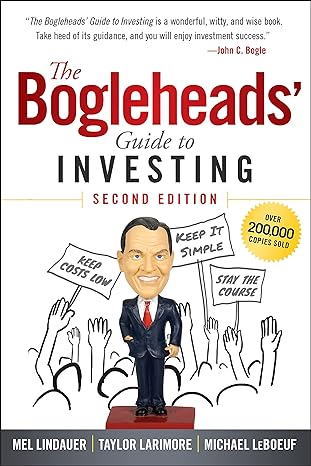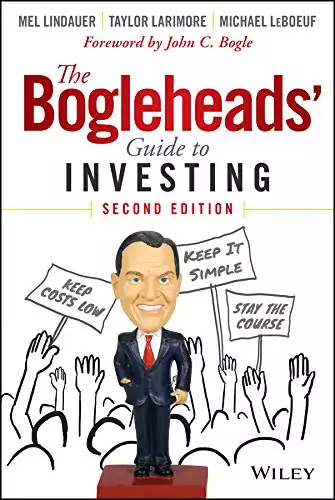Overview : The Bogleheads' Guide to Investing
- Book Title: The Bogleheads' Guide to Investing
- Author: Taylor Larimore, Mel Lindauer, Michael LeBoeuf
- Publication Date: January 2006
- price: $15.00
- Pages: 336
Overview of the Book
The Bogleheads' Guide to Investing is authored by Taylor Larimore, Mel Lindauer, and Michael LeBoeuf. They are dedicated followers of John C. Bogle's investment philosophy, emphasizing low-cost, long-term investing for financial independence.
Introduction
The Bogleheads' Guide to Investing, written by Taylor Larimore, Mel Lindauer, and Michael LeBoeuf, is a comprehensive manual for investors who seek to follow the investment principles of John C. Bogle, the founder of the Vanguard Group. The Bogleheads' Guide to Investing is authored by Taylor Larimore, Mel Lindauer, and Michael LeBoeuf. In an era of complex financial products and volatile market trends, "The Bogleheads' Guide to Investing" emerges as a beacon of clarity and wisdom. This seminal work, inspired by the investment philosophies of John C. Bogle, founder of Vanguard Group, offers a refreshing approach to personal finance and investing that emphasizes simplicity, cost-efficiency, and long-term thinking. They are dedicated followers of John C. Bogle's investment philosophy, emphasizing low-cost, long-term investing for financial independence.Published in January 2006, this book aims to provide practical, straightforward advice on how to build and manage an investment portfolio with an emphasis on simplicity, low costs, and long-term success.
Book Summary
At its core, "The Bogleheads' Guide to Investing" advocates for a straightforward investment strategy centered around low-cost index funds. The authors, seasoned investors themselves, present a compelling case for why individual investors should focus on passive investment strategies rather than attempting to beat the market.
"The stock market is a giant distraction from the business of investing." - John C. Bogle
This quote encapsulates the book's philosophy, emphasizing the importance of staying focused on long-term goals rather than getting caught up in short-term market fluctuations.
Analysis of Key Themes
1. The Power of Index Funds
The book provides an in-depth exploration of index funds, explaining how they offer broad market exposure, low operating expenses, and minimal portfolio turnover. The authors present convincing evidence supporting the superiority of index funds over actively managed funds, aligning with current market trends that show a growing preference for passive investing strategies.
2. Cost Efficiency in Investing
A central tenet of the Boglehead philosophy is the critical importance of minimizing investment costs. The authors demonstrate how high fees and expenses can significantly erode investment returns over time, advocating for low-cost index funds and ETFs as a means to capture market performance while keeping expenses low.
3. Comprehensive Investment Planning
Beyond index funds, the book covers a wide range of topics essential for holistic financial management:
- Asset allocation strategies
- Diversification techniques
- Tax-efficient investing
- Retirement planning
- Estate planning considerations
This comprehensive approach ensures readers gain a well-rounded understanding of personal finance management.
4. Behavioral Finance Insights
The authors delve into investor psychology, addressing common behavioral biases that can hinder investment success. By exploring concepts like market timing, panic selling, and overconfidence, the book offers valuable strategies for maintaining discipline during volatile market conditions.
Writing Style and Accessibility
One of the book's greatest strengths is its accessibility. The authors use clear language and relatable examples to explain complex financial concepts, making it suitable for readers with varying levels of investment knowledge. Whether you're a novice investor or looking to refine your existing strategy, "The Bogleheads' Guide to Investing" offers insights relevant to today's financial landscape.
Strengths and Weaknesses
Strengths:
- Clear, concise explanations of complex financial concepts
- Strong emphasis on cost-efficient investing
- Practical advice applicable to various stages of an investor's journey
- Incorporation of behavioral finance principles
Weaknesses:
- Limited coverage of active investment strategies
- Primarily U.S.-centric perspective, which may require international readers to seek additional resources
- Minimal discussion of alternative asset classes, including cryptocurrencies
Comparison to Other Works
While "The Bogleheads' Guide to Investing" shares similarities with other personal finance classics like "A Random Walk Down Wall Street" by Burton Malkiel and "Common Sense on Mutual Funds" by John C. Bogle himself, it stands out for its accessible approach and community-oriented perspective. Unlike more technical works, this book strikes a balance between educational content and practical application, making it an ideal starting point for those new to investing.
The Bogleheads Community
A unique aspect of the book is its emphasis on the Bogleheads community. The authors encourage readers to engage with this online forum, where investors can seek advice, share experiences, and continue their financial education. This sense of community sets "The Bogleheads' Guide to Investing" apart from other financial texts, offering ongoing support and learning opportunities.
Highlights from The Bogleheads’ Guide to Investing
- Index investing: Advocates for low-cost, passive investing through index funds.
- Diversification: Emphasizes the importance of a diversified portfolio to minimize risk.
- Long-term approach: Encourages a buy-and-hold strategy for consistent growth.
- Low fees: Highlights how minimizing fees can significantly impact long-term returns.
- Asset allocation: Suggests a balanced mix of stocks, bonds, and cash based on risk tolerance.
- Financial independence: Promotes managing investments to achieve long-term financial security and independence.
Conclusion
"The Bogleheads' Guide to Investing" is an essential read for anyone looking to build a solid financial foundation in today's complex economic environment. By advocating for simplicity, discipline, and cost-efficiency, the authors provide readers with timeless principles to achieve financial independence. In a world where financial products are becoming increasingly complex and market volatility is a constant concern, the Bogleheads' approach offers a refreshing and proven strategy for long-term success. Whether you're just starting your investment journey or looking to optimize your existing portfolio, this guide is an invaluable addition to your financial library.





